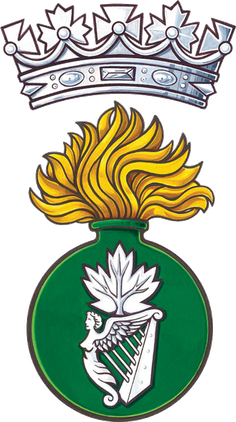First World War
On 6 August 1914, the 11th Regiment Irish Fusiliers of Canada was placed on active service for local protection duties. [3]
On 7 November 1914, the 29th Battalion, CEF was authorized for service and on 20 May 1915, the battalion embarked for Great Britain. On 17 September 1915, the 29th Battalion disembarked in France where it fought as part of the 6th Canadian Infantry Brigade, 2nd Canadian Division in France and Flanders until the end of the war. On 30 August 1920, the 29th Battalion was disbanded after its return to Canada. [3]
On 27 October 1914, the 30th Battalion, CEF was authorized and on 23 February 1915, the battalion embarked for Great Britain. After its arrival in the UK, on 18 April 1915, it was redesignated as the 30th Reserve Battalion, CEF to provide reinforcements for the Canadian Corps in the field. On 4 January 1917, its personnel were absorbed by the '1st Reserve Battalion, CEF and on 1 September 1917, the 30th Battalion was disbanded.
On 22 December 1915, the 102nd Battalion, CEF was authorized and on 18 June 1916, the battalion embarked for Great Britain. On 12 August 1916, the 102nd Battalion disembarked in France where it fought as part of the 11th Canadian Infantry Brigade, 4th Canadian Division in France and Flanders until the end of the war. On 30 August 1920, the 102nd Battalion was disbanded after its return to Canada. [3]
On 22 December 1915, the 121st Battalion, CEF was authorized and on 14 November 1916, the battalion embarked for Great Britain. After its arrival in the UK, the battalion provided reinforcements for the Canadian Corps in the field. On 10 January 1917, its personnel were absorbed by the 16th Reserve Battalion, CEF and on 17 July 1917, the 121st Battalion was disbanded. [3]
On 22 December 1915, the 158th Battalion, CEF was authorized and on 14 November 1916, the battalion embarked for Great Britain. After its arrival in the UK, the battalion provided reinforcements for the Canadian Corps in the field. On 4 January 1917, its personnel were absorbed by the 1st Reserve Battalion, CEF and on 27 July 1917, the 158th Battalion was disbanded. [3]
Second World War
Irish Fusiliers (Vancouver Regiment)
On 26 August 1939, detachments from the Irish Fusiliers were called out on service and on 1 September 1939, placed on active service under the designation 'Irish Fusiliers (Vancouver Regiment), CASF for local protection duties. On 31 December 1940, those details called out on active service were disbanded. [3] [4]
On 1 January 1941, the regiment was subsequently mobilized for active service as the 1st Battalion, Irish Fusiliers (Vancouver Regiment), CASF. The battalion served in Canada in a home defence role as part of the 18th Canadian Infantry Brigade, 6th Canadian Infantry Division. From 18 May 1943 to 6 August 1944, the battalion served on garrison duty in Jamaica. On 10 January 1945, the battalion embarked for Great Britain. After its arrival in the UK, on 19 January 1945, the battalion was disbanded to provide reinforcements to the First Canadian Army in the field. [3] [4]
On 12 May 1942, the regiment also mobilized the 3rd Battalion, Irish Fusiliers (Vancouver Regiment), CASF. The battalion served in Canada in a home defence role as part of the 19th Canadian Infantry Brigade of Pacific Command. On 15 August 1943, the 3rd battalion, Irish Fusiliers (Vancouver Regiment) was disbanded. [3] [4]
102nd Battery
On 26 August 1939, the 102nd Battery was called out for service and on 1 September 1939, details of the battery were placed on active service under the designation of the 102nd (North British Columbia) Heavy Battery, RCA, CASF for local protection duties. On 31 December 1940, those details called out on active service were disbanded. [3]
On 1 January 1941, the battery subsequently mobilized as the 102nd (North British Columbia) Heavy Battery, RCA, CASF for active service. On 1 May 1942, it was redesignated the 102nd Coast Battery, RCA, CASF. The battery served in Canada in a home defence role with the 17th (North British Columbia) Coast Regiment, RCA, CASF as part of Pacific Command. On 31 October 1945, the battery was disbanded. [3]
